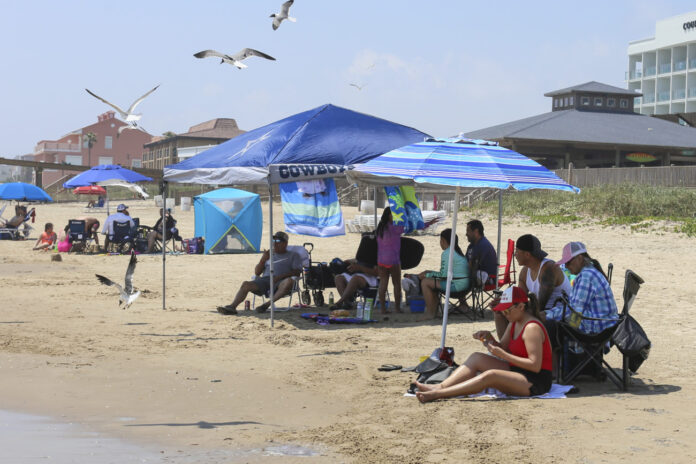In his first press conference after Cameron County beaches were reopened the last weekend of April, county Judge Eddie Treviño Jr. said he was relieved — in the name of social distancing — that there wasn’t a massive, mad dash to the seashore.
His relief lasted a week. The first weekend of May saw throngs make their way to South Padre Island to fill up hotel rooms and beaches. Health experts credit the county’s early implementation of mandatory shelter-in-place orders with keeping the number of coronavirus cases relatively low, though what happened on the Island over the weekend looked like the opposite of that just based on sheer numbers.
The sudden spike in visitation was made possible by Gov. Greg Abbott’s order, announced April 27, that restaurants, retail shops and certain other businesses would be allowed to reopen with partial occupancy beginning May 1. No doubt Island businesses in limbo the past several weeks due to official restrictions aimed at limiting the spread of the virus were happy to bring in much needed revenue.
Ed Caum, director of the SPI Convention and Visitors Bureau, said the first week of May is normally the start of the Island’s busy season. On May 2, 10,866 vehicles crossed the Queen Isabella Memorial Causeway to get to the Island, a number that included day trips and overnight visitors, he said, noting that the travel industry uses two and a half people per vehicle as a baseline for estimating the number of people. Using the baseline, the Island had 27,215 incoming visitors on Saturday alone. Friday and Sunday had 8,977 and 7,833 incoming vehicles, respectively, Caum said.
As for concerns over the spread of COVID-19, he said Island businesses are following guidelines from the state and the Centers for Disease Control and Prevention in terms of disinfecting areas, personal hygiene and social distancing, noting that bars are still closed under the governor’s order, though restaurants are allowed to be open at 25 percent occupancy.
Roxanne Ray, president and CEO of the SPI Chamber of Commerce, said most Island businesses authorized to be open under the governor’s order are either opening or working toward opening under the established guidelines.
“This past weekend was very busy, lots of people on the Island,” she said. “We continue to promote safe conduct that is encouraged by the CDC. We have also heavily disseminated cleaning and operating protocols as offered by the CDC. While we hope that everyone is being cautious and is complying, social media has of course exposed a few people stretching the rules.”
Ray said successfully reopening the Island, the county and the state “depends on every individual taking personal responsibility for their actions whether they are a resident, visitor or a business owner, using what we all have learned about COVID-19 and doing everything we can to limit the spread of the virus as we move forward beyond quarantine and the economic shutdown.”
Dr. Joseph McCormick, an expert on the some of the world’s deadliest diseases, epidemiology professor and founder and former dean of the UTHealth School of Public Health Brownsville Regional Campus, has lived on the Island with his wife, fellow epidemiologist Dr. Susan Fisher-Hoch, for 15 years. He has said consistently during the COVID-19 pandemic that reopening the economy without widespread testing of the population is inviting catastrophe.
While many people will continue to practice social distancing, wear masks and so on in public, others won’t to the point that the number of infections is virtually guaranteed to balloon once restrictions are lifted, McCormick said.
“We’ve said it many times,” he said. “There will be many people who do pay attention, but there will be enough that don’t pay attention that it will cause disaster. So we’re bracing for a new wave.”
On Tuesday, Abbott announced that hair salons would be allowed to reopen on May 8 and gyms on May 18, though occupancy limits will be in effect. McCormick said he believes businesses can reopen safely as long as they strictly adhere to COVID-19 guidelines, but that they should also be testing their employees regularly to make interactions safer and more comfortable for staff and customers alike.
The problem continues to be that the county doesn’t have enough tests to do that. Meanwhile, the White House’s own projections show 3,000 people dying each day from COVID-19 by the end of the month, a figure that signals a virus running rampant in the United States, McCormick said. Harvard recommends a minimum of 150 tests per 100,000 people, while California is up to around 170 tests per 100,000, he said.
McCormick said Texas is well below 100 tests per 100,000 people, while Brownsville is at about 80 per 100,000 — roughly half of where we should be — though he praised the testing efforts implemented by Cameron County, the City of Brownsville and the University of Texas Rio Grande Valley. Still, testing capacity falls far short of recommended guidelines, he said.
McCormick called on public officials and the private sector — businesses — to form a coalition to fill the gap, noting that there are now dozens of sources for FDA-approved tests around the country.
“At this point my feeling is that we should understand by now that neither the federal or the state governments apparently will step up to do the testing,” he said. “The bottom line here is to me every local entity is going to have to … develop their own plan for trying to get up to the level of testing we need, to be able to securely follow these guidelines.”
McCormick said it’s literally in everyone’s interest to do so, from business owners to first responders to the average person on the street.
“We’ll never eliminate risk, but we can sure mitigate it,” he said. “Why wouldn’t there be a coalition? Who’s going to bring this together? I’ve even got a contact in Houston where we could get testing done at Baylor in the Human Genome Center. My point is there are lots of things happening like that now, where we can get testing. There are tests becoming available, to know where the virus is.”







